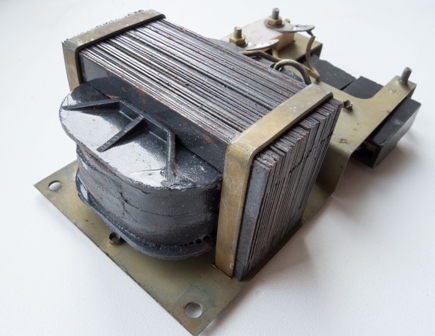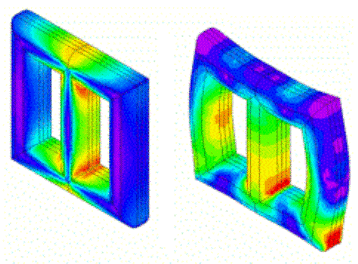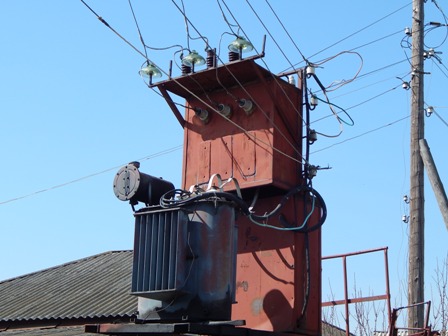Categories: Featured Articles » Interesting Facts
Number of views: 50973
Comments on the article: 0
Why is the transformer humming
The teacher asks Vovochka: - Vovochka, and who does your dad work with? - Transformer, Maria Ivanovna. - And how is that? - Well, he gets 380 rubles, gives 220 to his mother, and buzzes the remaining 160 ...
Why is the transformer humming? Have you ever thought about this? Someone will say that this is because the coils are poorly fixed between themselves or the windings oscillate, knocking on iron. Maybe the core area turned out to be less than the required by calculations, or did too many volts per turn turn out during winding? Does the frequency supplied correspond to this core material? Let’s understand, however.

In fact, the cause of transformer humming is initially magnetostriction. Magnetostriction is the phenomenon of changes in the size and shape of a ferromagnetic body under the influence of an alternating magnetic field.
The sizes and shape of ferromagnetic bodies depend on the state of their magnetization. James Joule in 1842 first discovered that when iron is introduced into the magnetic field, the latter changes its shape, elongating in one direction relative to the field and shortening in the other. The body volume of the body did not noticeably change.
So, if a ferromagnet is placed in a magnetic field, then this will primarily lead to a change in its resulting magnetization. At the same time, a change in body size will occur due to the fact that spontaneous magnetization changes its direction in different parts of the body, and therefore, the direction of spontaneous deformations in them also changes. This is a property that is inherent in all bodies (ferromagnets only in the most striking form).
In addition to magnetostriction, noise can be caused by working oil pumps and fans of cooling systems of powerful transformers. The electrodynamic forces in the windings and the electromechanical devices that regulate the voltage under load also create noise.

To a significant extent, the level of this noise depends on the magnitude of the electromagnetic load and the overall dimensions of the transformer. And the noise is based on the vibration of a ferromagnetic magnetic circuit that accompanies magnetostriction. The severity of the phenomenon depends on the magnitude of the magnetic induction, as well as on the structure and physical characteristics of the electrical steel itself. Further, the vibration is transmitted to the oil and core supports, and from the oil and core supports - directly to the tank.

Since the wavelength for the mains frequency in the transformer oil is approximately 12 meters, and the tank wall is located at a small distance from the core, the tank completely receives and reproduces the corresponding vibrations of the neighboring parts of the core.
Sometimes other noise sources turn out to be louder, for example, the same active cooling system, however, it is the core magnetic noise caused by magnetostriction that generally dominates.

Under the influence of an alternating magnetic field, the core experiences alternating magnetostrictive deformations. And if the steel sheets from which the core was drawn would experience tension directly proportional to the square of the magnetic induction, then the magnetostrictive vibrations would have one stable frequency equal to 100 Hz for 50 Hz network. However, in reality this dependence is not directly proportional, and the vibrations, and after them the vibration of the tank, produce noise with higher harmonics.

For both cold-rolled and hot-rolled electrical steels, data on the relative quantitative elongation during magnetostriction are available. Hot rolled sheet steel with a high silicon content almost completely prevents the manifestation of magnetostriction, and 6% of silicon added to the transformer steel almost blocks it.But such steel cannot be used in transformers due to its poor mechanical characteristics.
In cold rolled steel, with the same value of magnetic induction, the elongation is less than in hot rolled steel. But due to the fact that the induction in the cores of cold-rolled steel is superior to the induction for hot-rolled steel, the elongations of the cores are approximately the same.
Studies have shown that the noise of a hot-rolled steel magnetic circuit with an induction value of 1.35 T corresponds to the noise of cold-rolled steel with a magnetic induction of 1.55 T. And with an increase in induction in the core of a cold-rolled steel transformer by 0.1 T, the noise becomes stronger by 8 dB.
The transformer core can also get into resonance with vibrations from magnetostriction, and even with harmonics of vibrations in the magnetic circuit. If the magnetic circuit or parts of the transformer fall into resonance with these harmonics, then the noise range with pronounced peaks will cover multiple harmonics of twice the network frequency.
It was experimentally confirmed that the harmonics of the magnetic circuit vibrations are especially pronounced at high values of magnetic induction, when a nonlinear portion of the magnetization curve transitions in the presence of an abundance of harmonics of magnetostrictive vibrations.

One of the main components of this noise in the transformer belongs to the transverse vibrations of the sheets. These distinct vibrations occur due to the difference in sheet length and thickness; as a result, the elongation factors for each sheet are different, and this leads to a change in the joint gap as a function of instantaneous induction values.
This leads to a redistribution in time of magnetic flux between adjacent sheets, and as a result transverse vibrations of the sheets are obtained. The magnetic flux changes in time, and with it the degree of saturation of the ferromagnet. The magnetization curve is distorted, and as a result, higher harmonics and magnetostriction noise appear.
It is important that the length of the core changes not only from magnetostriction, but also under the influence of magnetic forces that arise when the magnetic flux passes from plate to plate. This happens when the parallel plates are distinguished by magnetic permeability.
It was experimentally confirmed that both longitudinal and transverse vibrations of the sheets generate vibrations and noise of approximately the same intensity. Therefore, even if one of the transformer noise sources is completely suppressed, the total noise will not decrease by more than 3 dB.
Reactors, reactors having structural air gaps are distinguished by noise caused precisely by magnetic forces. Between two parts, separated by a gap, alternating forces of attraction arise with a double magnetization frequency.
The noise caused by electrodynamic forces in the windings of a transformer operating under load is usually quite quiet if there are no axial backlash, as is typical for elastic winding pressing. Therefore, the load level of this noise transformer is practically independent.
This position allows you to normalize the noise level of the transformer. However, the nature and magnitude of the load is still associated with magnetic induction in transformer steel during operation, therefore, the level of magnetic noise with the load power is still related.
We hope that this short article allowed an inexperienced reader to get an answer to the question of why the transformer is buzzing.
It is interesting:How to find out the power and current of a transformer by its appearance
See also at bgv.electricianexp.com
:
